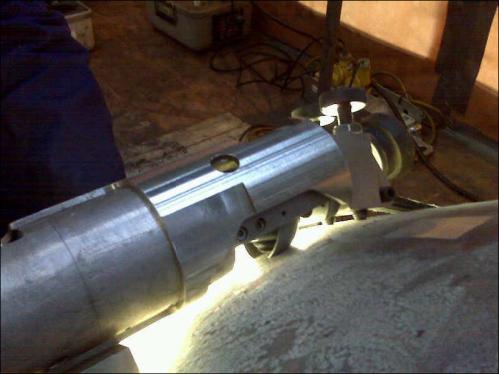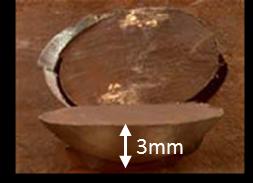Use of novel small specimen testing methods for improvements in power plant maintenance operations
Submitting Institution
University of NottinghamUnit of Assessment
General EngineeringSummary Impact Type
TechnologicalResearch Subject Area(s)
Engineering: Civil Engineering, Manufacturing Engineering, Materials Engineering
Summary of the impact
A range of small specimen creep testing methods have been developed
through research carried
out at the University of Nottingham (UoN). These tests are being used in
the following ways: RWE
npower has used the impression creep test on approximately 180 samples
taken from its power
plants in the UK, France and Holland; AMEC has installed two impression
creep test rigs for testing
nuclear power plant materials for a range of EDF Energy power plants;
Laborelec is using the
small ring techniques for evaluating nickel based super alloys in turbine
blades for clients in
Belgium and Holland and the Electrical Power Research Institute (EPRI) has
used the small
specimen techniques, with the assistance of UoN, on power plant structures
in the USA.
Underpinning research
"Creep" is a feature found in the vast majority of power station failures
in the UK and worldwide.
This is because the combination of stress, temperature, and pressurisation
over time results in a
degradation of material properties, especially where two parts are welded
together. If creep is not
monitored and mitigated it can lead to catastrophic failure, including the
bursting of steam pipes or
boilers, resulting in millions of pounds of lost revenue on top of the
cost of repairing the damage.
It is in this area that UoN's Tom Hyde (Professor of Mechanical
Engineering, UoN, 1978 - present)
and Adib Becker (Professor of Mechanical Engineering, UoN, 1990 - present)
have focused an
important part of their research. The work was initiated in 1996
through an EPSRC-funded three-year
project aimed at developing a procedure for assessing the performance of
repaired welds at
elevated temperature [Grant P1]. This research was carried out with
industrial collaborators EDF
Energy, National Power (later merged with RWE to become RWE npower) and
PowerGen. It
involved the UoN team developing new mathematical models of material
behaviour and
incorporating these into Finite Element codes [2.1]. This was followed by
experimental studies on
the behaviour of repaired welds at high temperatures (up to 640 celsius),
resulting in new holistic
methods for the prediction of creep failure in welds operating at high
temperatures.

 Figure 1: Scoop sampling in progress (left), extracted scoop sample
(right)
Figure 1: Scoop sampling in progress (left), extracted scoop sample
(right)
The success of the above project resulted in further EPSRC funding for
research into the structural
integrity of power plant welds and plant life extension, again with the
leading power plant operators
[P2, P3, P4, P5]. These projects — carried out between 2000 and 2012 -
enabled the UoN team to
combine individual expertise in Finite Element (FE) modelling, metallurgy
and material science.
Again, the research provided a route to engaging with the leading power
plant operators in the UK
and their parent companies in Europe.
In this series of research projects UoN performed the Finite Element
modelling of creep crack
growth and fundamental analysis of the parent, weld and heat affected
zones in welds [2.2, 2.3]
and then assessed residual life to determine the power plant structural
integrity [2.4]. Outcomes
included an understanding of where reliable samples of material could be
taken without
compromising the weld, and innovative methods for extracting and testing
the samples.
The sampling techniques developed through this research enable tests on
miniature specimens
machined from "scoop" samples removed from the components (Figure 1). Two
such specimen
tests — the Impression Creep Test (ICT [2.5]) and the Small Ring Test (SRT
[2.6]) - were
developed as a direct result of the research. Both tests have
mechanics-based procedures for
interpreting the results obtained from them, meaning that once the samples
have been taken using
the sampling methodologies the actual tests can be performed on standard
universal tensile testing
machines, which are in widespread use.
References to the research
Publications (Items marked with an asterisk indicate 3 most
significant papers);
2.1 Hyde, T.H, Sun, W. and Becker, A.A., 1997, Creep continuum damage
constitutive equations
for the base, weld and heat-affected zone materials of a service-aged
1/2Cr1/2Mo1/4V:21/4Cr1Mo multipass weld at 640 degrees C, Journal of
Strain Analysis for
Engineering Design, 32 (4), 273-285 DOI: 10.1243/0309324971513409,
copy available on
request.
2.2 Hyde, C.J., Hyde, T.H., Sun, W. and Becker, A.A., 2010, Damage
mechanics based predictions
of creep crack growth in a 316 stainless steel, Engineering Fracture
Mechanics, 77 (12), 2385-2402
DOI: 10.1016/j.engfracmech.2010.06.011
2.3 Hyde, T.H., Saber, M. and Sun, W., 2010, Testing and modelling of
creep crack growth in
compact tension specimens from a P91 weld at 650ºC, Engineering
Fracture Mechanics, 77
(15), 2946-2957 DOI: 10.1016/j.engfracmech.2010.03.043
2.4 *Sun, W., Hyde, T.H. and Brett, S.J., 2008, Application of impression
creep data in life
assessment of power plant materials at high temperatures, Journal of
Materials: Design and
Applications, 222, 175-182 DOI: 10.1243/14644207JMDA183
2.5 *Hyde, T.H., Sun, W. and Becker, A.A., 1996, Analysis of the
impression creep test method
using a rectangular indenter for determining the creep properties in
welds, International Journal
of Mechanical Sciences, 38, 1089-1102 DOI:
10.1016/0020-7403(95)00112-3,
2.6 *Hyde, T.H. and Sun, W., 2009, A novel, high sensitivity, small
specimen creep test, Journal of
Strain Analysis, 44 (3), 171-185 DOI: 10.1243/03093247JSA502
Grants:
P1 EPSRC GR/L14930/01, 1996-1999: The development for a procedure for
assessing the
performance repaired welds at elevated temperature (ercos) (PI Hyde)
P2 EPSRC GR/N10011/01, 2000-2003: Structural integrity of high
temperature welds in power
generation plant (PI Hyde)
P3 EPSRC GR/N63444/01, 2000-2003: Establishment of an academic-industrial
network in
electricity supply research (PI Hyde)
P4 EPSRC GR/S86334/01, 2004-2008: SUPERGEN 2 - Conventional Power Plant
Lifetime
Extension Consortium (PI Hyde)
P5 EPSRC EP/F029748/1, 2008-2012: SUPERGEN 2 - Conventional Power Plant
Lifetime
Extension Consortium - CORE (PI Hyde)
Details of the impact
The small specimen creep testing methods developed by the UoN research
team have been used
by at least four major organisations serving the power industry — either
directly (RWE npower) or
by providing services to power plant operators (Laborelec, AMEC and EPRI).
These companies
have benefited through improving the performance of existing plants or
preventing potential future
losses. Training and consultancy provided by the UoN team in the use of
the new tests have
resulted in changed industry practices.
The full economic value of the impact to the power industry is reflected
through avoidance of cost.
Steve Brett [4.1] confirmed that for this reason, the power industry is
unable to quantify the total
cost of incidents avoided through use of these methods. The following
examples provide an
indication of the reach and significance of the impact.
The impression creep testing method developed as part of the original
research has been used by
RWE npower (turnover €50.7Bn, operating in 17 countries) since 2008 for
plant life assessment
and targeted maintenance in steam-carrying boiler pipes in the UK, France
and the Netherlands.
Although it is difficult to estimate the full monetary impact of the
technology, over 180 tests have
been performed to date on power plants in the UK. A specific example of
the use of this method
and the resulting prevention of cost at RWE npower was provided by the
then Corporate Engineer
Materials and Welding at RWE npower, Steve Brett, in March 2013:
Chromium Molybdenum Vanadium (CrMoV) Steam Pipe Bend
"Cracking was found on a number of bends on the CrMoV steam pipework
systems at several UK
power stations. The bends had all been replaced at some stage in the
station life and had
apparently not been manufactured in the same way as the original bends
(many of which were still
operating) in these systems. RWE npower identified one bend with a suspect
microstructure and in
June 2010 carried out small-scale sampling as part of further
investigation. lmpression creep
testing at Nottingham University showed the creep strength of the bend
material, although
relatively weak, to be no weaker than material in the adjacent original
bends. On the basis of this it
was decided to leave the bend in service, albeit with an increased
inspection regime. A new bend
would have cost an estimated ~£40k. The cost of a steam leak from a CrMoV
pipework system
varies with the time of year. The average cost has been estimated to be
~£200k, but the cost at a
time of peak winter electricity demand may be closer to £1M." [4.1].
Other direct beneficiaries of the research include AMEC, one of the
world's leading engineering
and consultancy services in the oil and gas market, with a turnover £4.1Bn
and operations in 34
countries. AMEC has installed two impression creep test rigs in its Risley
laboratory and since
2011 has used them to undertake a range of tests on high-temperature
materials for major power
companies in the UK, including EDF nuclear power plants [4.2].
Since 2010 Laborelec, a technical service provider for the electrical
power and energy industry
(turnover €48M, operating in 4 countries), has been using the small ring
test on virgin nickel based
superalloy material used in gas turbine blades for power companies in the
Netherlands and
Belgium. Laborelec's expert on structural integrity assessments, Steve
Nardone, has remarked:
"The small-ring test technique has proved its value by providing robust
creep data compared with
conventional uniaxial data. Alongside conventional uniaxial creep testing
and in support of it, the
small-ring testing technique can refine our creep assessment and therefore
improve our remaining
life assessment techniques, which could optimise maintenance and
replacement of equipment in
the near future." [4.3].
The original research conducted at UoN has resulted in an international
reputation for the
academics involved. They have widely shared their knowledge with members
of the US-based
Electric Power Research Institute (EPRI), which has more than 1,000
members worldwide, mainly
working in electricity generation and delivery. The UoN team has trained
member companies since
2011 to enable them to perform impression creep tests. This has translated
into tests being
performed in power plants across the USA, and the data generated from
these tests has resulted
in EPRI funding of two projects at UoN (value USD$120k) on the
interpretation of small punch test
data.
The research outcomes have been made available to other practitioners
through two workshops
and one seminar. An International Practitioners Meeting was organised in
March 2011, an
International Expert Group Workshop in June 2011 and an IMechE Seminar in
February 2012, at
the University of Nottingham, on small specimen testing, which attracted
more than 20 senior level
decision makers from the power industry based in the UK, France, Belgium,
Finland, the
Netherlands and the USA.
Sources to corroborate the impact
4.1 Statement from Steve Brett, now retired from RWE npower available on
file
4.2 Statement from Andrew Wisbey, Section Leader, High Temperature
Materials, AMEC available
on file
4.3 Statement from Steve Nardone, Structural Integrity Assessment &
Monitoring, Laborelec
available on file